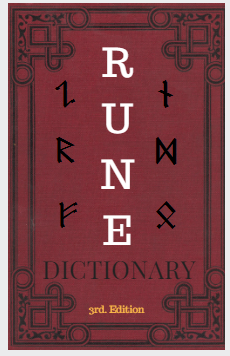Rune Dictionary
By Venita Wessex
An introduction to the interpretation and usage of Germanic runes.
Last Updated
May 31, 2021
Chapters
16
Reads
55584
Chapter 13: The Fragments of Hagall’s Aett in the Younger Futhark
Chapter 15
ᚼ ᚽ Hagalaz --- Hagall <Phonetic value:</b> /h/, as in the English high, the French hotte, and the Spanish ojo Meaning: Hail Changes: The shape of the rune changed drastically from the Elder Futhark to the Younger Futhark. ᚾ ᚿ Naudhiz --- Nauðr or Naudh Phonetic value: /n/, as in the English month, the French connexion, and the Spanish cantar Meaning: Constraint / Need Changes: In addition to keeping the original meaning of need, Naudh also can indicate constraint, or some sort of restriction. ᛁ Isa --- Íss or Is Phonetic value: /i/, as in the English free, the French fini, and the Spanish tipo /e/, as in the English bird Meaning: Ice Changes: The additional /e/ sound, explained in more detail below, is new and was not included in Isa -- the parent rune’s -- possible sound values. Magical Uses: Because of its shape, it is difficult to tell when the rune being used is from the Elder Futhark, a confirmed magical script, and the Younger or Anglo-Saxon. However, some inscriptions and bindrunes seem to possess a magical effect not generally attributed to Isa. These few inscriptions that seem to intent to enhance the clarity of various divining methods are used as proof by the scholarly sub-group who believes in the magical meanings of the younger runic scripts. General Notes: This particular expression of the /e/ sound is further clarified as “ɜ” and pronounced as such. ᛅ ᛆ Jera --- Ar Phonetic value: /a/, as in the English, stock, the French patte, and the Spanish madre /æ/, as in the English cat, and the French bain /ɔ/, as in the English thought, and the French sort Meaning: Plenty / Harvest Changes: This rune bears little resemblance to the shape of its parent rune in the Elder Futhark. The sound values show further changes. Neither the original /j/ or /i/ (also expressed as “y’) have been preserved, and instead there are variations on the vowel “a”. Harvest has remained as a meaning, but has also been expanded to mean plenty, a meaning which was absent in the original Elder Futhark. ᛦ ᛣ ᛧ Eihwaz --- Yr Phonetic value: /j/, as in the English you, the French yeaux, and the Spanish ayer Meaning: Yew tree Changes: The rune shape has changed from one futhark to the other, and the pronunciation has changed from the original “eo” sound to the “y” sound. General Notes: It may surprise you to see the initial letter of the English word “you” represented by the symbol /j/, but this is not an error, and in fact the sound that English speakers associate with “y.” Note: the “a” sound is not part of the pronunciation, it is used as a break between the first and second repetitions of /j/. However, it useful to note that for ease of quick reference, the sound is often simply written “y” in pronunciation guides for speakers of English. ᛋ ᛍ Sowilo --- Sol Phonetic value: /s/, as in the English sand, the French façade, and the Spanish saltador [ks], which those who speak English think of as “x”, as in the English six Meaning: Sun Changes: In addition to retaining its original /s/ phonetic value, Sol has additional sound of “ks.”


